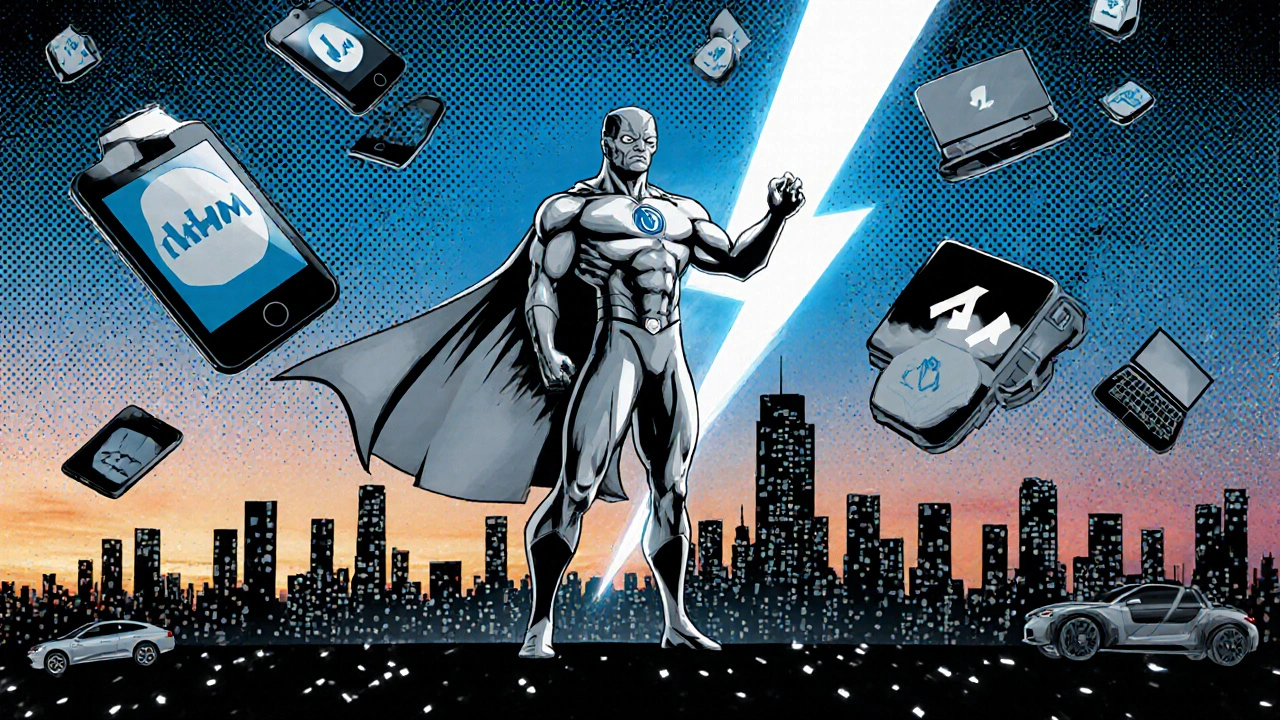
Lithium Battery Comparison Tool
Compare Lithium Battery Technologies
Select metrics to display and see how different lithium-based battery technologies compare.
Li-ion (2024)
Solid-State
Lithium-Sulfur
Lithium-Air
Data based on article content from "The Future of Lithium: Emerging Technologies and Potential Applications". Actual performance may vary by manufacturer and application.
Key Takeaways
- Lithium is moving beyond traditional Li‑ion cells into solid‑state, sulfur and air chemistries.
- Emerging batteries promise higher energy density, faster charge and better safety.
- New applications include grid‑scale storage, electric aviation and medical devices.
- Sustainable sourcing and recycling are critical to avoid resource bottlenecks.
- Industry roadmaps suggest commercial solid‑state packs by 2030 and lithium‑sulfur pilots by 2027.
What is lithium and why it matters
When people hear “lithium,” they often think of mood‑stabilising pills. In fact, lithium is a soft, silvery metal that ranks as the lightest solid element on the periodic table. Its low atomic weight and high electrochemical potential make it ideal for storing and releasing energy quickly.
Because of those properties, lithium powers more than 30% of modern consumer electronics, fuels the surge in electric vehicles (EVs), and underpins the transition to renewable energy. As the world leans harder on clean power, the demand for lithium‑based solutions is set to explode.
Current lithium‑ion landscape
The classic lithium‑ion battery (Li‑ion) has dominated since the early 1990s. A typical cell packs about 250Wh/kg and can be recharged hundreds of times. Its architecture-graphite anode, liquid electrolyte, lithium cobalt oxide cathode-balances energy density, cost and safety.
However, Li‑ion cells face three hard limits:
- Energy density is capped by the graphite anode.
- Liquid electrolytes can catch fire under abuse.
- Cobalt and nickel sourcing raise ethical and geopolitical concerns.
These constraints are driving research into next‑generation lithium chemistries.

Emerging lithium‑based technologies
Four contenders are gaining traction. All keep lithium at the core but replace one or more components to lift performance.
Solid‑state battery (SSB)
Solid‑state batteries substitute the liquid electrolyte with a solid ceramic or polymer. The solid medium can tolerate a lithium‑metal anode without forming dendrites, which are tiny metal filaments that can short‑circuit a cell.
- Energy density: 350‑500Wh/kg, up to 2× Li‑ion.
- Charge speed: 10‑15minutes for an 80% charge in prototype packs.
- Safety: Non‑flammable electrolyte eliminates thermal runaway.
Industry giants such as Toyota and QuantumScape forecast production‑scale SSBs by 2030, aiming first at premium EVs.
Lithium‑sulfur battery (Li‑S)
The lithium‑sulfur battery swaps the traditional metal‑oxide cathode for elemental sulfur. Sulfur is cheap, abundant and lightweight.
- Theoretical energy density: 2600Wh/kg-five times Li‑ion.
- Challenges: polysulfide shuttling reduces cycle life; researchers use nanostructured host materials to trap dissolved species.
Recent pilots in aerospace have demonstrated 500‑Wh/kg specific energy, enough to cut aircraft weight by 20%.
Lithium‑air battery (Li‑O₂)
Lithium‑air batteries draw oxygen from the ambient air to react with lithium, creating lithium peroxide during discharge. This approach promises the highest gravimetric energy of any rechargeable system.
- Theoretical energy density: 11000Wh/kg.
- Real‑world hurdles: air‑catalyst degradation, moisture sensitivity, and low round‑trip efficiency.
While still at laboratory scale, Li‑air could someday power long‑haul drones or serve as ultra‑light backup for remote sensors.
Nanostructured lithium‑metal anodes
Beyond whole‑cell chemistries, engineers are engineering the anode itself. Lithium‑metal anodes paired with protective nanolayers can deliver 10‑20% higher capacity than graphite while keeping dendrite growth in check.
Companies such as Sion Power report 1000‑cycle lifetimes at 90% depth‑of‑discharge in 2024 prototypes.
Potential applications beyond batteries
Lithium’s reactivity and low weight make it useful outside electrochemistry.
Renewable energy storage
Large‑scale grid storage installations increasingly rely on lithium chemistry. Hybrid systems that combine Li‑ion for fast response and Li‑S for seasonal capacity are being trialled in California and Germany.
Medical devices and pharmaceuticals
In the health sector, lithium isotopes (6Li, 7Li) serve as tracers in PET imaging, while trace lithium carbonate remains a first‑line treatment for bipolar disorder. Emerging research suggests low‑dose lithium could protect neurons from age‑related degeneration.
Aviation and space
Ultra‑light Li‑S packs are being qualified for electric vertical take‑off and landing (eVTOL) aircraft. NASA’s Artemis program also explores lithium‑based regenerative fuel cells for lunar habitats.
Challenges and sustainability
Scaling any lithium technology hits the same bottlenecks: raw material supply, environmental impact, and end‑of‑life handling.
Extraction and geopolitics
Today, 60% of global lithium comes from the “Lithium Triangle” (Argentina, Bolivia, Chile). Water‑intensive brine pumping strains local ecosystems. Hard‑rock mining in Australia and Canada offers higher purity but consumes more energy.
Battery recycling
Effective battery recycling can recover up to 95% of lithium, cobalt and nickel. Mechanical‑hydrometallurgical loops, such as those deployed by Li-Cycle, achieve 90% recovery rates while reducing hazardous waste.
Policy shifts in the EU (2026 mandatory recycling targets) and the US (2024 Battery Act) are accelerating commercial recycling capacity.
Safety and standards
New chemistries demand updated testing protocols. The International Electrotechnical Commission (IEC) is drafting a 2025 standard for solid‑state cell abuse tolerance.

Roadmap to 2035
Putting all the pieces together, here’s a realistic timeline:
- 2025‑2027: Pilot‑scale Li‑S and nanostructured Li‑metal anodes in niche aerospace and high‑end EVs.
- 2028‑2030: First commercial solid‑state packs in luxury cars; grid‑scale hybrid storage trials.
- 2031‑2033: Volume production of Li‑S for commercial drones and stationary storage; recycling infrastructure reaches 30% of global flow.
- 2034‑2035: Li‑air demonstrators in remote off‑grid power; policy‑driven circular lithium economy reduces primary extraction to below 40% of demand.
Achieving this path requires coordinated R&D, supportive regulation and transparent supply chains.
Comparison of emerging lithium technologies
| Metric | Li‑ion (2024) | Solid‑state | Lithium‑sulfur | Lithium‑air |
|---|---|---|---|---|
| Energy density (Wh/kg) | 250 | 350‑500 | ~500 (prototype) | 1000‑3000 (lab) |
| Cycle life (full‑depth) | 1200‑2000 | 800‑1200 | 200‑500 | 50‑150 |
| Charge time (80% SOC) | 30‑45min | 10‑15min | 30‑60min | - |
| Safety rating* | Moderate (flammable electrolyte) | High (non‑flammable) | Moderate (polysulfide mitigation needed) | Low (oxygen handling) |
*Safety rating based on IEC 62660 draft criteria.
Frequently Asked Questions
Why is lithium preferred over other metals for batteries?
Lithium’s low atomic mass and high electrochemical potential give it the highest energy‑to‑weight ratio of any metal, which directly translates into longer run‑times for portable devices and lighter electric cars.
When will solid‑state batteries be widely available?
Prototype packs are already on test benches, and most analysts expect mass‑market solid‑state EV batteries to hit showrooms around 2030, initially in premium models.
Can lithium‑sulfur batteries replace Li‑ion in smartphones?
Not yet. Li‑S still struggles with cycle life and moisture sensitivity, which are critical for consumer gadgets that see daily charging cycles.
How does recycling affect lithium demand?
Effective recycling can recover up to 95% of lithium from spent packs, potentially cutting primary extraction needs by 40% by 2035 if global collection rates reach current EU targets.
Is lithium‑air realistic for commercial use?
Lithium‑air still faces fundamental chemistry problems-especially oxygen‑induced degradation-so it remains a long‑term research focus rather than an imminent product.
Michael Ieradi
September 10, 2025 AT 23:03Wow, the landscape of lithium technology is evolving at breakneck speed, and the data in this post really highlights the breadth of innovation; from solid‑state breakthroughs to the lofty promises of lithium‑air, the field is buzzing with activity. The solid‑state section stands out because of its non‑flammable electrolyte, which could finally address the safety concerns that have haunted traditional Li‑ion cells for years. Additionally, the reported charge times of 10‑15 minutes for an 80 % charge are nothing short of impressive, especially when you consider the typical 30‑45 minute window for current batteries. The lithium‑sulfur discussion is equally compelling, with its theoretical energy density of 2,600 Wh/kg suggesting a potential game‑changer for aerospace applications. However, the cycle‑life limitations-200‑500 cycles-remain a critical hurdle that must be overcome before mass adoption. The article’s inclusion of lithium‑air, with its eye‑popping 11,000 Wh/kg theoretical value, reminds us that we are still chasing the holy grail of energy storage. Yet the practical challenges, such as moisture sensitivity and low round‑trip efficiency, cannot be ignored. The roadmap to 2035 is realistic, laying out a phased approach that aligns well with current R&D pipelines. I appreciate the balanced take on sustainability, emphasizing recycling rates that could reach 95 % recovery with modern hydrometallurgical processes. The mention of policy shifts in the EU and the US adds a valuable geopolitical dimension to the technical discussion. Moreover, the table comparing metrics provides a quick visual reference that is both clear and informative. The safety rating hierarchy-moderate, high, moderate, low-offers a concise way to gauge risk across chemistries. It is also noteworthy that the article addresses raw material sourcing, highlighting the environmental pressures in the Lithium Triangle. By calling out water‑intensive brine extraction, the author shows an awareness of broader ecological impacts. The section on nanostructured lithium‑metal anodes presents promising data, with 1,000‑cycle lifetimes at 90 % depth‑of‑discharge, indicating that incremental improvements are on the horizon. Overall, this post serves as a comprehensive primer for anyone interested in the future of lithium, blending technical depth with accessible language. Finally, the inclusion of potential applications-from grid storage to eVTOL aircraft-underscores the pervasive influence of lithium technologies across sectors.
Stephanie Zuidervliet
September 12, 2025 AT 02:50Honestly, reading this feels like watching a sci‑fi blockbuster-so much hype, so many bold claims!!! The solid‑state hype is real, but the practical rollout might be a slow burn, not an overnight miracle.
Olivia Crowe
September 13, 2025 AT 06:36Great overview! The optimistic timeline gives me hope that our electric future is closer than we think.
Aayush Shastri
September 14, 2025 AT 10:23In India, we're already seeing pilot projects for lithium‑sulfur packs in remote telecom towers, and the collaborative spirit described here resonates with our push for sustainable energy solutions.
Dominique Jacobs
September 15, 2025 AT 14:10Yo, the energy density numbers are insane-500‑plus Wh/kg for Li‑S? That's the kind of boost we need to kick gasoline to the curb, and I'm all in for pushing these techs into the market ASAP.
Dawn Mich
September 16, 2025 AT 17:56Don't forget who's really pulling the strings behind those "pilot projects"-big oil still has a secret stake in the lithium supply chain.
Eric Sevigny
September 17, 2025 AT 21:43Just a heads up, the recycling numbers you quoted (90 % recovery) are based on the newer hydrometallurgical loops, not the older pyrometallurgical ones, which typically hit around 70‑80 % efficiincy.
Glenda Rosa
September 19, 2025 AT 01:30Honestly, those recycling stats are a sugar‑coated fairy tale-most manufacturers still dump half their spent cells in landfills, so the "circular economy" narrative is nothing but greenwash glossed over with buzzwords.
Francisco Garcia
September 20, 2025 AT 05:16I see both sides: while the current recycling infrastructure may lag, the recent EU mandates are forcing companies to revamp their processes, and early adopters are already reporting up to 85 % material reclamation; this suggests a shifting tide towards genuine sustainability, even if the journey is still rocky.